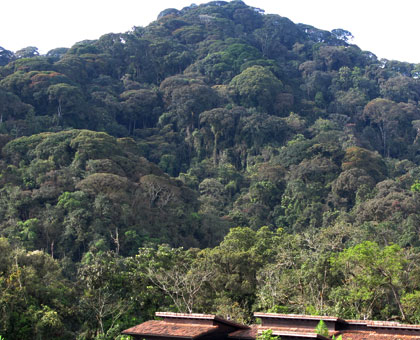The Ministry of Natural Resources has unveiled a new monitoring system to cut greenhouse gas emissions due to deforestation and forest cover degradation.


The Ministry of Natural Resources has unveiled a new monitoring system to cut greenhouse gas emissions due to deforestation and forest cover degradation.
The greenhouse gas monitoring and reporting scheme is a reflection of the government’s commitment to protecting forests and encouraging sustainable development, said Adrie Mukashema, deputy director-general of forests in the Ministry of Natural Resources.
"Although we have little, we make sure that what we have is sustainably managed,” Mukashema said.
Rwanda has 700,000 hectares of forest, covering 28.8 per cent of land surface. In 2005, 23 per cent of Rwanda was covered by forest, she said.
In 2008, members of the United Nations Framework Convention on Climate Change (UFCCC) developed the Reducing Emissions caused by Deforestation and forest Degradation (REDD+) programme.
Countries seeking to participate in the programme were asked to develop a national system for measuring, monitoring and reporting emissions and periodically submit emissions information to the UFCCC.
Rwanda is one of 10 Central African countries that received funding, $400,000 from the Congo Basin Forest Fund to develop a reporting system.
The ministry has been working on a REDD+ reporting system since May, last year, and it will be sent to the UN for approval this month.
Dr Donat Nsabimana, one of six experts who created Rwanda’s preliminary REDD+ plan, presented the framework to a group of environmental experts. It will be finalised next week after consultations with governmental and NGO representatives.
Deforestation emissions
The UN REDD+ programme is focused on reducing emissions from deforestation and forest degradation, conservation and enhancement of forest carbon stocks, as well as sustainable management of forests.
Rwanda will undertake environmental and social assessments to look at the negative impacts of forestry on the environment and its contribution to greenhouse gas emissions.
Forests are essential to stabilising climate change, but they can also be part of the problem due to deforestation and forest degradation.
The UNFCCC has found that forestry contributes to 17.4 per cent of greenhouse gas emissions in developing countries.
To be able to assess Rwanda’s greenhouse gas levels, Nsabimana said government should establish a reference based on historical emissions.
"We need to have our own scenario and once we have it, discuss it with UN REDD+,” Nsabimana said.
Currently, there is no base emission level for measuring. He said the ministry also needs to define which forests it will be measuring and when.
Meeting the target
Once Rwanda’s emission measuring programme is approved by UN, it will rely on a multi-pronged approach of land use planning, land tenure rights, and involvement of the private sector to ensure the forestry industry is not raising greenhouse gas emissions.
Nsabimana said $6 million (about Rwf4 billion) was needed to implement the REDD+ plan for three years.
Currently, government has pledged $2 million and an unknown amount of money will come from unnamed international and national donors.
Mukashema said greenhouse gas levels in the country are currently at an acceptable scale, but they could become a problem if more measures are not taken to monitor forests and other sources of greenhouse gas emissions.
She said the rising temperature in the country is also a cause for concern and a motivating factor behind Rwanda’s commitment to the UN’s REDD+ programme.


